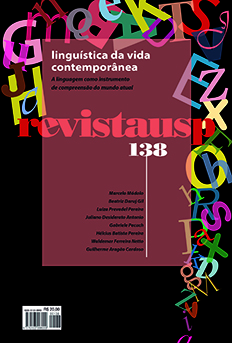É verdade ou fake news? Estratégicas linguísticas de manipulação em textos que promovem a desinformação
DOI:
https://doi.org/10.11606/issn.2316-9036.i138p27-38Keywords:
Fake news, Misinformation, Manipulation strategies, Epistemic modality, EvidentialityAbstract
Fake news have become a major problem in the modern world due to the fact that they are spread very quickly over the internet and influence many people in matters such as politics, economics, science and health. During the covid-19 pandemic, it was possible to observe how fake news can be harmful to society, leading to disbelief in vaccines on the part of many people and the use of ineffective medicines as a form of self-medication by the population. Thus, it is important to investigate linguistic characteristics of texts that promote disinformation to find patterns or clues that may lead to a greater understanding of how fake news are constructed. In this article, we try to present two linguistic strategies used in the construction of fake news in order to manipulate information.
Downloads
References
AIKHENVALD, A. Y. Evidentiality. New York, Oxford University Press, 2004.
ALBA-JUEZ, L.; MACKENZIE, L. “Emotion, lies, and ‘bullshit’ in journalistic discourse: the case of fake news’. Ibérica, n. 38. Madri, 2019, pp. 17-50.
ALLCOTT, H.; GENTZKOW, M. “Social media and fake news in the 2016 Election”. Journal of
Economic Perspectives, v. 31, n. 2, 2017, p. 211-36.
BYBEE, J. Morphology: a study of the relation between meaning and form. Amsterdam, John Bengamins, 1985.
DALL’AGLIO HATTNHER, M. M. “Uma análise funcional da modalidade epistêmica”. Alfa: Revista de Linguística, v. 40, 1996.
FREITAG, R. M. “O papel da frequência de uso na gramaticalização de acho (que) e parece (que) marcadores de dúvida na fala de Florianópolis”. Veredas, v. 7, n. 1 e n. 2, 2003, pp. 113-32.
MAILLAT, D.; OSWALD, S. “Constraining context: A pragmatic account of cognitive manipulation”, in C. Hart (ed.). Critical discourse studies in context and cognition. Amsterdam, John Benjamins, 2011, pp. 65- 80.
MICK, J. “Profissionalismo e confiança: o curioso caso do país que acredita mais nos jornalistas do que na mídia”. Política & Sociedade, v. 18, n. 43, Florianópolis, 2019.
MONTEIRO, R. A. et al. “Contributions to the study of fake news in Portuguese: new corpus and automatic detection results”. Proceedings of the 13th international conference on the computational processing of Portuguese (PROPOR). Canela, September, 2018, pp. 324-34.
NERI, F. “Boato sobre Bolsa Família chegou a ao menos 12 estados, diz ministério”. G1. 19/mai./2013. Disponível em: http://g1.globo.com/brasil/noticia/2013/05/ministradescartapossibilidade-desuspensao-do-bolsa-familia.html. Acesso em: 10/jul./2022.
NEVES, M. H. de M. Texto e gramática. São Paulo, Contexto, 2011.
PANTAZI, M.; KISSINE, M.; KLEIN, O. “The power of the truth bias: false information affects memory and judgment even in the absence of distraction”. Social Cognition, vol. 36, n. 2, 2018, pp. 167-98.
VAN SWOL, L. “Truth bias”, in T. Levine (ed.). Encyclopedia of deception. California, Sage Publications, 2014, pp. 904-6.
Downloads
Published
Issue
Section
License
Copyright (c) 2023 Revista USP

This work is licensed under a Creative Commons Attribution-NonCommercial-ShareAlike 4.0 International License.
|
Pertence à revista. Uma vez publicado o artigo, os direitos passam a ser da revista, sendo proibida a reprodução e a inclusão de trechos sem a permissão do editor. |


